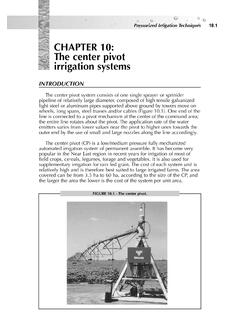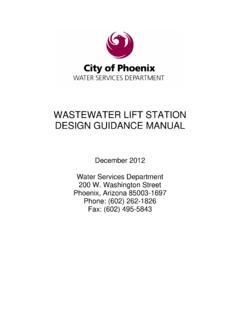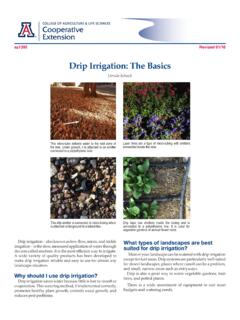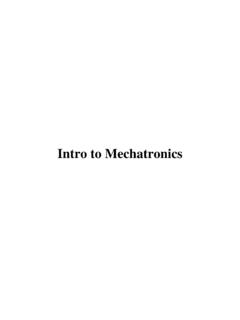Transcription of Climate resilient practices - FAO
1 Climate resilient practices Typology and guiding material for Climate risk screening33 Typology and guiding material for Climate risk screeningClimate resilient practicesFOOD AND AGRICULTURE ORGANIZATION OF THE UNITED NATIONSROME, 2021 Climate resilient practices Typology and guiding material for Climate risk screeningJorge Alvar-Beltr n, Ilyasse Elbaroudi, Arianna Gialletti, Ana Heureux, Lev Neretin, Riccardo SoldanClimate resilient practicesThe designations employed and the presentation of material in this information product do not imply the expression of any opinion whatsoever on the part of the Food and Agriculture Organization of the United Nations (FAO) concerning the legal or development status of any country, territory, city or area or of its authorities, or concerning the delimitation of its frontiers or boundaries.
2 The mention of specific companies or products of manufacturers, whether or not these have been patented, does not imply that these have been endorsed or recommended by FAO in preference to others of a similar nature that are not views expressed in this information product are those of the author(s) and do not necessarily reflect the views or policies of FAO. FAO, 2021 FAO encourages the use, reproduction and dissemination of material in this information product. Except where otherwise indicated, material may be copied, downloaded and printed for private study, research and teaching purposes, or for use in non-commercial products or services, provided that appropriate acknowledgement of FAO as the source and copyright holder is given and that FAO s endorsement of users views, products or services is not implied in any way.
3 All requests for translation and adaptation rights, and for resale and other commercial use rights should be made via or addressed to FAO information products are available on the FAO website ( ) and can be purchased through citation:Alvar-Beltr n, J., Elbaroudi, I., Gialletti, A., Heureux, A., Neretin, L. Soldan, R. 2021. Climate resilient practices : typology and guiding material for Climate risk screening. Rome, 11 Cropping systems2-92 Livestock systems10-123 Forest systems13-154 Fisheries, aquaculture and international waters16-175 Biodiversity18-196 Climate resilient practices along food value chains20-257 Governance on Climate change mitigation and adaptation 26-28 Bibliography 29-301 Climate resilient practicesIntroductionA key element required for sustainable and transformational development in agriculture is ensuring that investments are informed by robust evidence about past and future Climate risks.
4 Climate resilience is a fundamental concept of Climate risk management. In this context, resilience refers to the ability of an agricultural system to anticipate and prepare fo r, as well as adapt to, absorb and recover from the impacts of changes in Climate and extreme weather. Resilience can be enhanced by implementing short and long-term Climate mitigation and adaptation strategies, as well as ensuring transparent and inclusive participation of multiple actors and stakeholders in decision-making and management processes. Some hydro-meteorological hazards are slow in their onset, such as changes in temperature and precipitation resulting in long-term altered temperature, rainfall patterns and agricultural droughts.
5 On the other hand, some occur much more suddenly, such as tropical storms and floods. Both require robust risk preparedness informed by the assessment of Climate objective of this publication is to support the Climate risk screening of agricultural investment projects. Climate risk is based on the exposure, main Climate hazards, vulnerabilities and the adaptive capacity of the agricultural, social, and ecological systems targeted by a given project. The Climate risk screening includes recommendations and Climate resilient measures to address the risks identified at the earliest stages of the investment project cycle.
6 A compendium of Climate resilient practices is presented to assist project developers and relevant stakeholders to consider enhanced Climate resilient measures and address the hazards identified in the Climate risk screening. This manual is intended to be a first reference point to guide Climate resilient , technical practices and governance strategies and to inform multi-risk analysis and local level consultations. During project design, the identified practices are matched to context-specific environmental and climatic conditions, considering agricultural, social, and economic assets, while also acknowledging the potential technical, economic barriers and limitations of each measure.
7 References with further details on specific practices are also provided in this guidance practices outlined are organized by agricultural sub-sectors and focal areas, as follows: crops, livestock, forestry, fisheries and aquaculture, biodiversity, value chains and governance. The most suitable Climate resilient practices will depend on the hazard risk, exposure and vulnerability observed during the Climate risk screening process. While the measures provide a reference point for project development teams, the full integration of resilience measures in investment projects will require further assessment and consultation during project design.
8 2 Typology and guiding material for Climate risk screeningCROPPING SYSTEMS 1 HAZARDSPRACTICESDESCRIPTION AND ADAPTATION/MITIGATION BENEFITSEXTREME HEATHeat tolerant crops ( quinoa, pearl millet, sorghum) or crop varieties Promote crops and/or crop varieties with a higher heattolerance and/or optimal heat range. Enhance yields in areas where temperatures are expected toexceed heat thresholds that are harmful to existing cycle varieties Reduce the effect of heat stress at key phenological phases(germination and flowering) and improve final yields. Reduce plants exposure to heat by shortening the growingcycle.
9 Reduce the total water requirements during the crop calendars Optimal crop calendars based on historical Climate data andseasonal forecasts support decision-making, avoiding heat-stress conditions at crop s sensitive phenological phases, andincreasing ( rock walls, roadways, high moisture and low resin plants, flame-retardant plants) Limit the spread and impact of wildfires on crops. Reduce social, environmental, and economic losses derivingfrom wildfires. Decrease air pollution by reducing black carbon WINDSW indbreakers Rows of trees can protect crops by breaking strong winds,reducing soil erosion, increasing crop yields, and protectinglivestock from heat and cold , FROST & HAIL Frost protection( plant row covers, irrigation, anti-frost candles, mulching, wind machines) Row covers increase downward long-wave radiation at nightand reduce heat losses by convection and advection.
10 Frost protection irrigation allows the release of latent heatfusion when water turns into ice, protecting the plant scanopy from extreme cold temperatures. Anti-frost candles can increase the air temperature ad reducethe plant s exposure to frost. Low or walk-in tunnel greenhouses warm the soil and protectplants from frost and wind. Canopy cover can provide protection against frost damagesby reducing net radiation resilient practicesHAZARDSPRACTICESDESCRIPTION AND ADAPTATION/MITIGATION BENEFITSCOLD, FROST & HAILF rost protection( plant row covers, irrigation, anti-frost candles, mulching, wind machines) Soil covering with mulching and/or other materials increasesthe surface temperature.



















